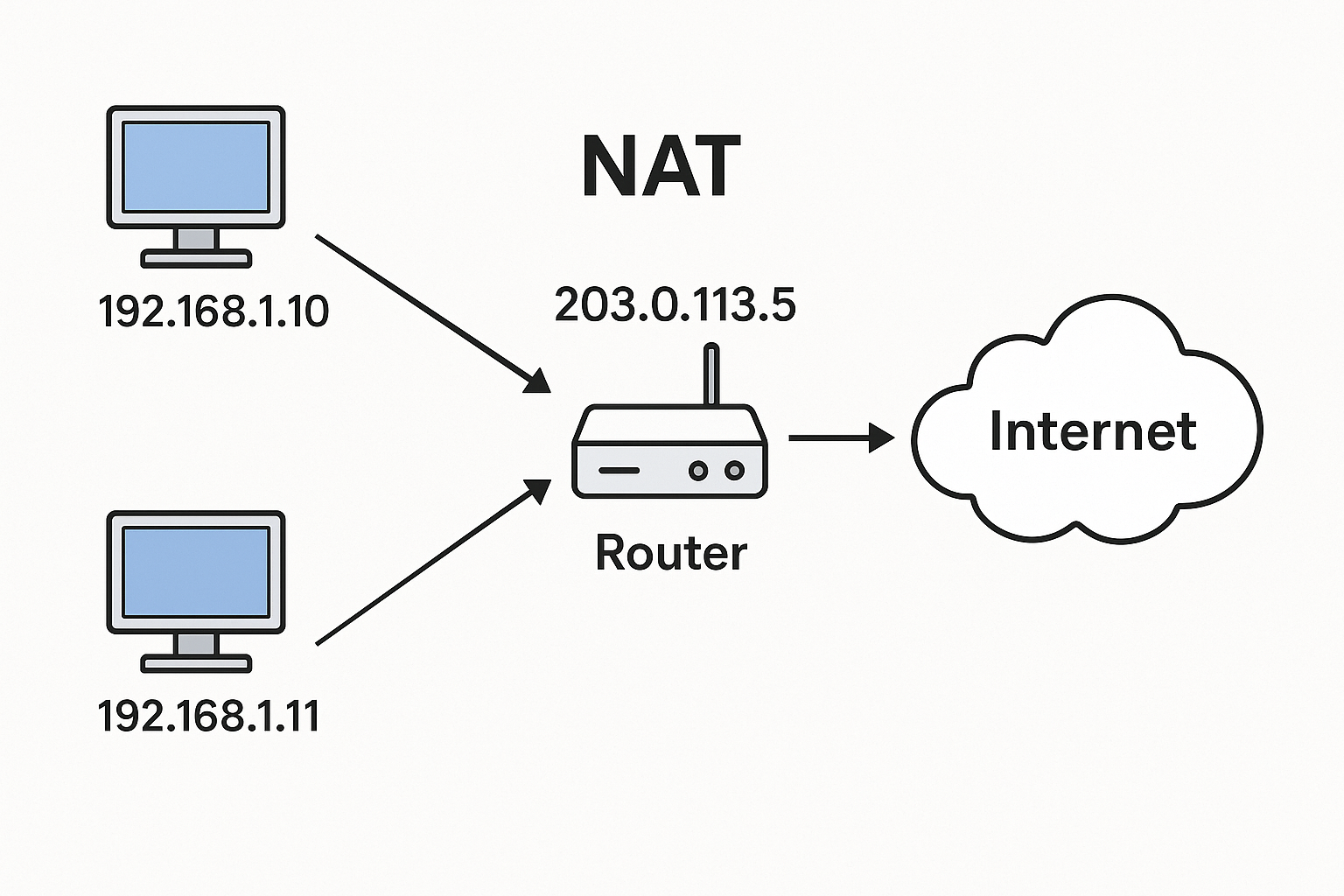🔁 What Is NAT (Network Address Translation)?

Network Address Translation (NAT) allows multiple devices on a private network to share one or a few public IPv4 addresses when accessing the Internet. It rewrites the source or destination IP address (and sometimes port numbers) of packets as they pass through a router or firewall, enabling private hosts to communicate with external networks securely and efficiently.
🔁 Why NAT Exists
The primary purpose of NAT is to conserve public IPv4 addresses and provide an extra layer of privacy. Since IPv4 addresses are limited, NAT lets organizations use private IP ranges (e.g., 192.168.x.x or 10.x.x.x) internally while using a single public IP for all outbound traffic.
🔁 Main NAT Types
Static NAT — One-to-one mapping between an internal IP and a public IP. Common for internal servers that must be reachable from the Internet.
Dynamic NAT — Internal IPs are mapped to public IPs from a pool, created temporarily as needed.
PAT (Port Address Translation) — Also known as NAT Overload. Multiple internal devices share a single public IP using different source ports. The most common NAT form is in home routers.
🔁 How PAT Works

When a device on a private LAN (e.g., 192.168.1.10:50000) sends traffic to the Internet, the NAT device replaces the source with its public IP (e.g., 203.0.113.5:40000). It records the mapping so that when responses return to 203.0.113.5:40000, they are correctly forwarded back to 192.168.1.10:50000. This mapping allows multiple devices to share one external IP address.
🔁 Benefits of NAT
Conserves IPv4 addresses by allowing many internal hosts to use one public IP.
Hides internal network structure, enhancing privacy.
Simplifies deployment, as end devices don’t need public IPs or complex routing.
🔁 Limitations of NAT
Breaks end-to-end connectivity, complicating peer-to-peer or inbound access.
Causes protocol issues when IP/port data is embedded (e.g., SIP, FTP).
Adds complexity to logging, troubleshooting, and scaling large deployments.
🔁 NAT and IPv6
IPv6 offers virtually unlimited IP addresses, reducing the need for NAT. Instead of translation, IPv6 encourages end-to-end communication with privacy and firewall mechanisms. NAT66 (IPv6-to-IPv6 translation) is generally discouraged except for specific use cases like address independence.
🔁 NAT Traversal Techniques
Applications needing direct peer connections (like VoIP or video calls) use NAT traversal protocols such as:
STUN / TURN / ICE – For WebRTC and real-time media.
UPnP / NAT-PMP – For automatic port mapping in trusted environments.
ALGs or static port forwarding – For legacy protocols requiring inbound access.
🔁 Best Practices for LINK-PP Customers
Match deployment scale:
Home or SMB: Use PAT on edge routers.
Enterprise/ISP: Use public address pools or CGNAT with detailed logging.
Enable NAT features: Support UPnP, dynamic mapping, and secure logging.
Plan for IPv6: Choose dual-stack network devices to reduce NAT dependency.
Security: Always pair NAT with a stateful firewall and updated firmware.
Looking for high-performance Ethernet connectors and PoE modules compatible with NAT-enabled devices?
Explore LINK-PP’s full range of RJ45 connectors and LAN magnetics to ensure stable, efficient network operation.
🔁 FAQ
Q: Is NAT the same as a firewall?
A: No. NAT modifies IP/port headers; a firewall filters traffic by policy. Many routers combine both.
Q: Does NAT protect my network from all threats?
A: Not entirely. NAT hides IPs but doesn’t block malicious traffic—firewalls are still required.
Q: Should I disable NAT if I use IPv6?
A: Yes, if possible. Use IPv6 with firewall protection instead of translation.


